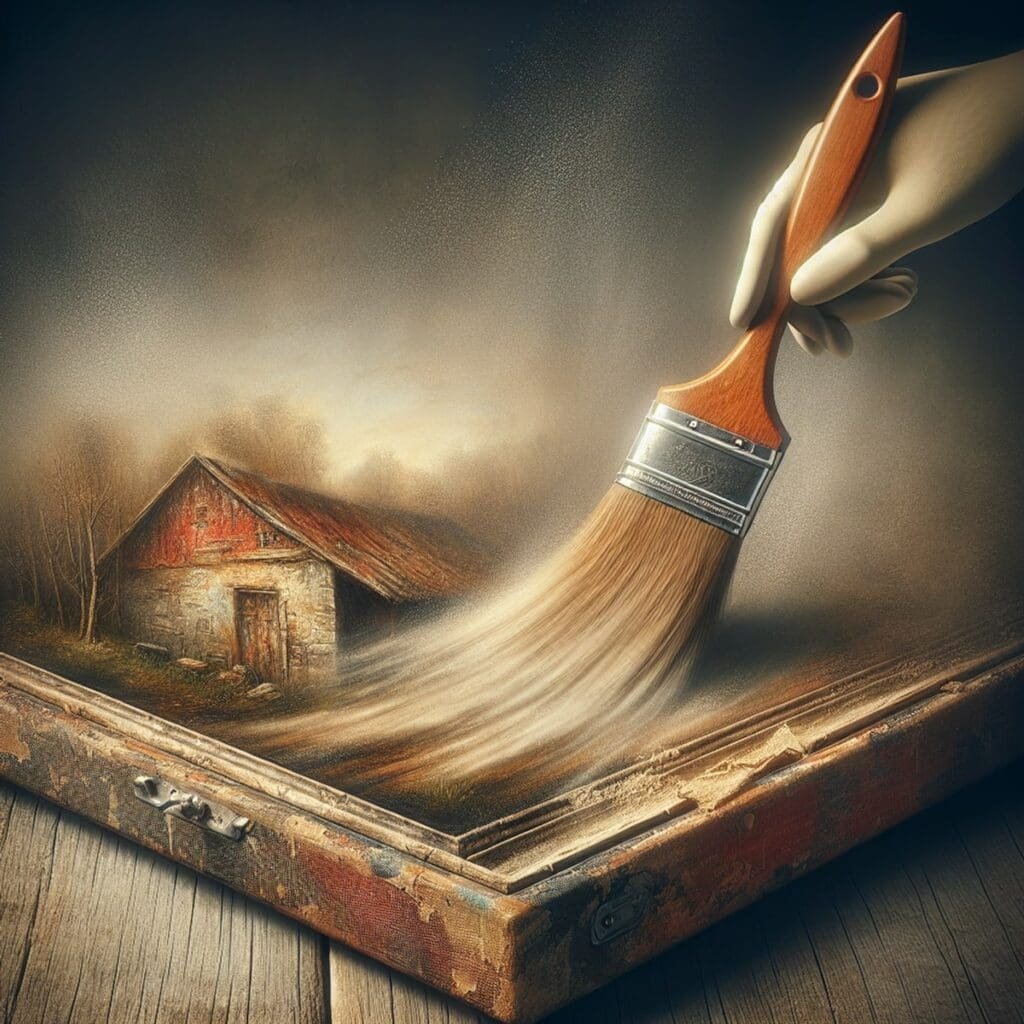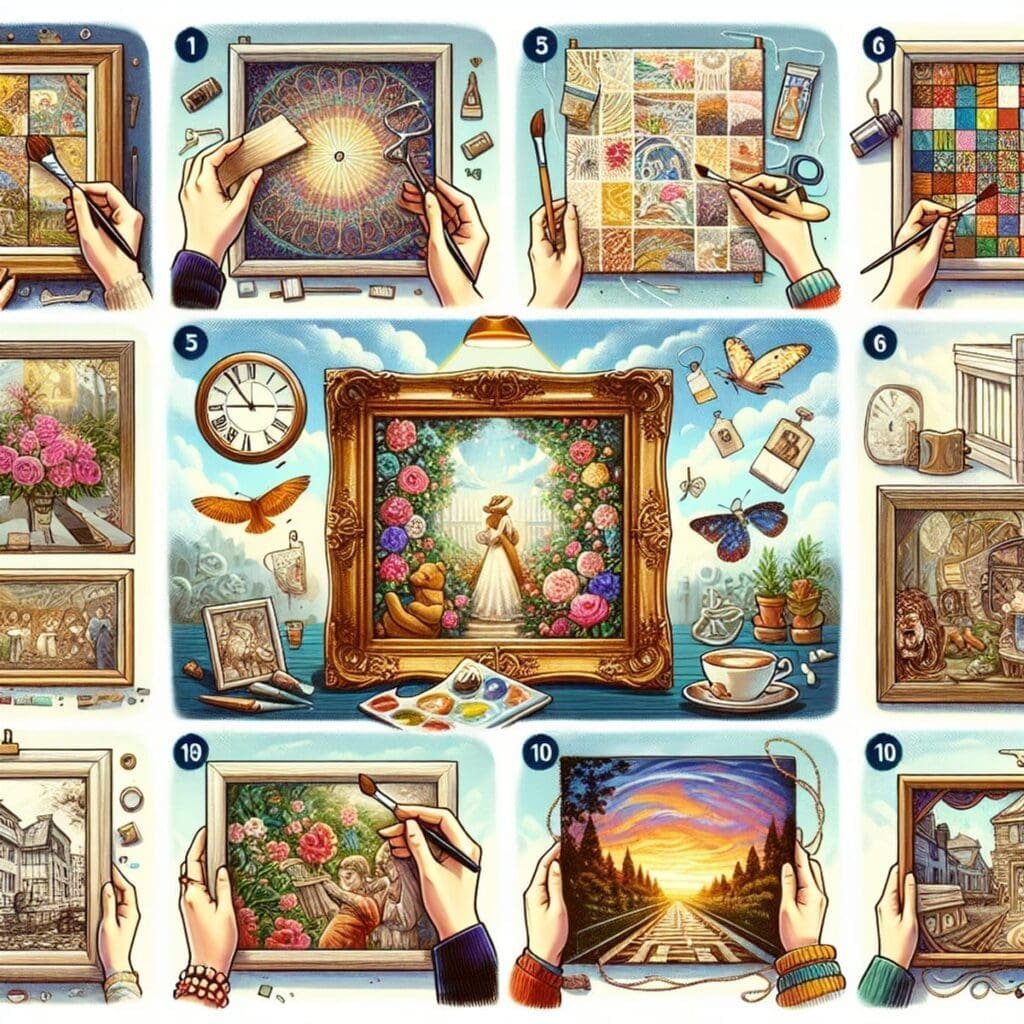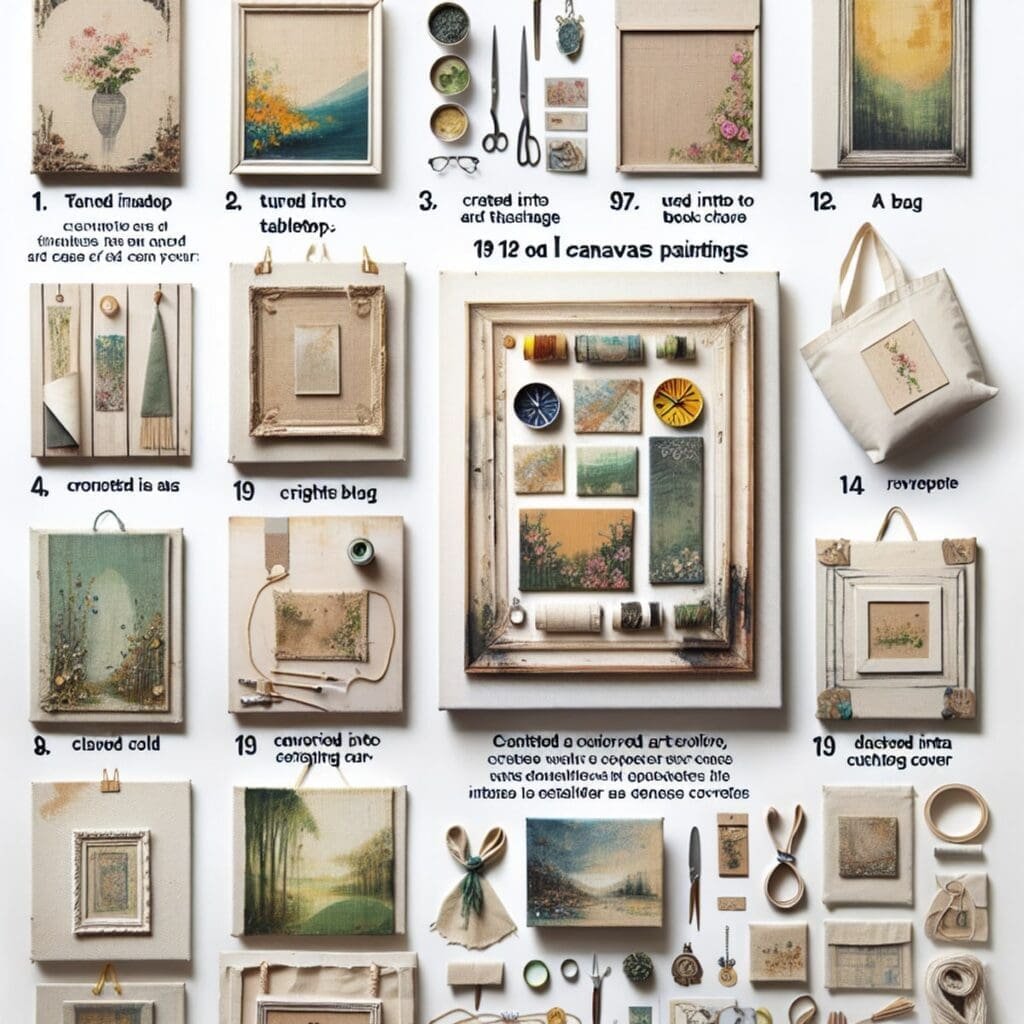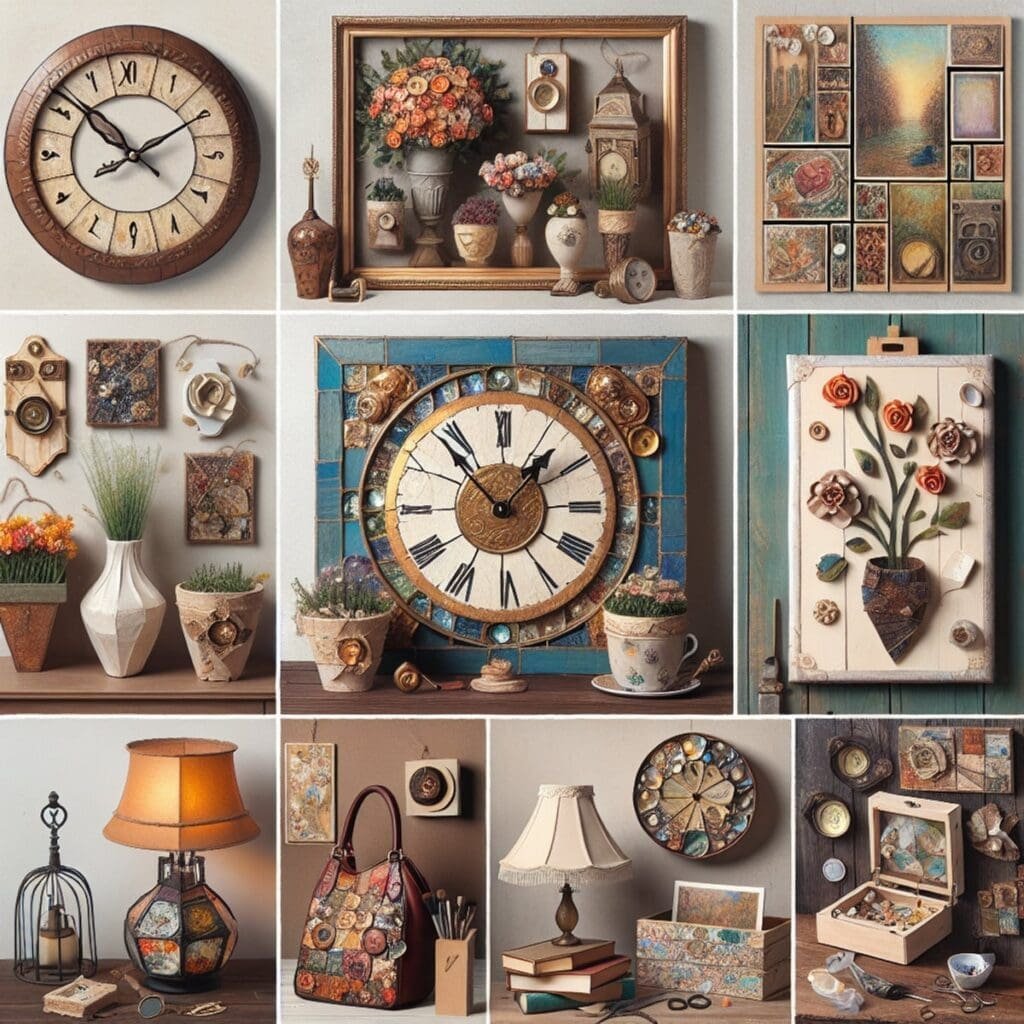
Introduction to Upcycle Old Canvas Paintings
Upcycling has become a popular trend in the art world, offering a creative and sustainable way to breathe new life into old materials. When it comes to old canvas paintings, there are endless possibilities for upcycling and transforming them into something fresh and exciting.
Not only does upcycling old canvas paintings allow you to unleash your creativity, but it also contributes to reducing waste and minimizing environmental impact.
By repurposing old canvas paintings, you can give them a new purpose and save them from ending up in a landfill. The process of upcycling involves:
- Resurfacing and preparing the canvas
- Exploring different painting techniques
- Embracing creative ideas to transform the old artwork into something entirely different
In this article, we will delve into the world of upcycling old canvas paintings and explore ten brilliant ways to bring new life to these forgotten pieces. Whether you’re an experienced artist or just starting out on your artistic journey, these ideas will inspire you to create something unique and meaningful.
1. Resurfacing and Preparing Old Canvas Paintings

Properly preparing the canvas surface is crucial for upcycling projects. By following these steps, you can ensure a smooth and durable base for your new artwork:
- Cleaning: Start by gently cleaning the old canvas painting to remove any dirt or debris that may have accumulated over time. Use a soft brush or cloth to wipe away loose particles, taking care not to damage the canvas.
- Sanding: If the existing paint layers are thick or uneven, sanding can help create a smoother surface. Use fine-grit sandpaper to lightly sand the entire canvas, focusing on areas with raised textures or rough patches. This step will help remove any imperfections and prepare the canvas for a fresh start.
- Applying Gesso Primer: Gesso is an essential primer that provides better adhesion for new materials or paints. Apply a thin, even layer of gesso over the entire canvas using a brush or roller. This will create a uniform surface and prevent the absorption of moisture from subsequent layers.
- Optional Sanding After Gesso Application: Some artists prefer to perform an additional round of sanding after applying gesso as it helps in achieving an even smoother texture.
By resurfacing and preparing your old canvas paintings, you can ensure that your upcycled creations have a solid foundation. This process not only enhances the longevity of your artwork but also allows for better paint adhesion and more vibrant colors.
2. Painting Techniques for Upcycled Canvas Art

Upcycling old canvases is not only an eco-friendly way to create art but also an opportunity to experiment with different painting techniques. Here are some ideas to get you started:
Oil Painting on a Gessoed Surface
Oil painting is known for its vibrant colors and smooth texture. When applied to a gessoed surface, it can create interesting effects such as:
- Blending: Use a brush or palette knife to blend colors seamlessly, creating soft transitions between shades.
- Impasto: Apply thick layers of paint with a palette knife to add texture and depth to your artwork.
- Glazing: Thin down your oil paint with a medium like linseed oil or turpentine and apply translucent layers over dry paint to create luminosity.
Enhancing with Linseed Oil
Linseed oil is a common medium used in oil painting. It has several properties that can enhance the richness and depth of oil paint on upcycled canvases:
- Increased Transparency: Mixing linseed oil with your paint can make it more transparent, allowing underlying layers to show through.
- Improved Flow: Adding linseed oil to your paint mixture can make it smoother and easier to work with, especially for techniques like glazing.
- Faster Drying Time: Linseed oil can speed up the drying time of oil paint, making it more convenient for layering and building up textures.
Remember to always use artist-grade materials and properly ventilate your workspace when working with oil paints. Happy experimenting!
repurpose old paintings
reuse canvas art
creative painting upcycling
revamp old canvas artwork
recycle painted canvases
renew old art pieces
refresh painted canvas
transform used canvas paintings
recreate old canvas art
reclaim painted canvases
restore outdated artwork
reinvent canvas paintings
redesign old art pieces
reutilize painted canvases
reimagine used canvas artwork
3. Creative Ideas for Upcycling Old Canvas Paintings artwork

When it comes to upcycling old canvas paintings, the possibilities are endless. By incorporating different artistic techniques and materials, you can transform your outdated artwork into stunning pieces that breathe new life into your space. Here are some creative ideas to inspire your upcycling journey:
1. Collage Art
One of the most popular techniques for upcycling old canvas paintings is collage art. This versatile method involves layering cut-out images, fabric scraps, and other found objects onto the canvas surface, creating a visually dynamic composition. To achieve a cohesive look, follow these steps:
- Begin by gathering a variety of materials such as old magazines, newspapers, photographs, fabric remnants, or even dried flowers.
- Cut out interesting shapes and images from your chosen materials.
- Arrange the cut-outs on the canvas, experimenting with different placements until you’re satisfied with the composition.
- Once you’ve finalized the layout, use adhesive mediums like mod podge or gel medium to secure the elements in place.
- Apply a thin layer of adhesive over each element and press them down gently to eliminate any air bubbles or wrinkles.
Collage art allows you to incorporate different textures and colors into your upcycled canvas painting, resulting in a unique and visually striking piece.
2. Abstract Expression
Embracing abstraction is another exciting way to upcycle old canvas paintings. This technique encourages experimentation with bold colors, textures, and gestural brushwork on the existing surface. To create an abstract expressionist artwork:
- Start by applying gesso primer to ensure better adhesion of new paint layers.
- Use vibrant colors and apply them liberally onto the canvas with expressive brushstrokes.
- Play with different tools or household objects to create interesting textures and patterns.
- Allow yourself to be guided by intuition rather than strict representation, allowing the artwork to evolve organically.
Abstract expressionism gives you the freedom to explore your emotions and create visually engaging pieces that showcase your unique artistic voice.
3. Mixed Media Fusion
Combining painting with other artistic mediums can add depth and dimension to your upcycled canvases. Experiment with techniques like collage, encaustic, or embroidery to create mixed media fusion artworks. Here’s how you can get started:
- Select compatible materials that complement each other in terms of texture and color.
- Integrate these materials into your composition, considering how they interact with the existing canvas and paint layers.
- For example, you could incorporate fabric scraps by sewing them onto the canvas or use encaustic wax to create a textured surface over the old paint.
- With mixed media fusion, you have the opportunity to create visually rich and multidimensional artworks that tell a story.
4. Stenciled Designs
Stencils are a versatile tool that can be used to create intricate patterns or motifs on old canvases. Whether you want to add details to large areas
2. Abstract Expression
In the world of art, there’s a style called abstract expressionism that allows artists to freely express themselves through bold colors, textures, and gestural brushwork. It’s a great way to breathe new life into old canvas paintings and give them a fresh, modern look.
Why Choose Abstract Expression?
Abstract expressionism offers endless possibilities for creativity and experimentation. Here are some reasons why you should consider this style for upcycling your old canvas paintings:
- Freedom of Expression: With abstract art, you don’t have to worry about creating realistic representations. Instead, you can focus on conveying emotions, ideas, or concepts through non-representational forms.
- Unleash Your Imagination: Abstract expressionism encourages you to think outside the box and explore unconventional techniques. It’s all about embracing spontaneity and letting your intuition guide the creative process.
- Transform Imperfections into Assets: If your old canvas paintings have flaws or areas that you’re not happy with, abstract expressionism can help you turn those imperfections into unique features of the artwork.
Techniques for Creating Abstract Art
Now that we’ve covered why abstract expressionism is a great choice for upcycling old canvas paintings, let’s dive into some techniques you can use to create stunning abstract artworks:
- Intuitive Mark-Making: Instead of planning every detail in advance, try making marks on the canvas based on your instincts and emotions. Use different types of brushes or even your fingers to create expressive lines, shapes, and textures.
- Layering and Collage: If your old canvas paintings have existing imagery or textures that you want to incorporate into your new artwork, consider using collage techniques. Cut out interesting shapes or patterns from magazines, newspapers, or other printed materials and glue them onto the canvas.
- Experimenting with Tools: Don’t limit yourself to traditional painting tools! Look around your house for everyday objects that you can use to create unique effects. For example, you can use a credit card to scrape paint across the canvas or a sponge to dab on colors.
- Playing with Color: One of the key elements of abstract art is color. Explore different color combinations and contrasts to evoke specific moods or create visual impact. You can use a color wheel as a guide or trust your instincts when choosing hues.
Remember, there are no right or wrong ways to create abstract art. The most important thing is to let your creativity flow and enjoy the process of transforming your old canvas paintings into something new and exciting!
3. Mixed Media Fusion
Keywords: creative ways to upcycle old canvas paintings, collage technique in upcycling old canvas paintings, mixed media approach to upcycling old canvas paintings
Why not try mixing things up?
One of the most exciting ways to transform your old canvas paintings is by combining different artistic techniques and materials. This not only breathes new life into your artwork but also allows you to explore your creativity in unconventional ways.
Here are some ideas to get you started:
- Collage: Cut out interesting shapes or patterns from magazines, newspapers, or old books and glue them onto your canvas. This tutorial on making a spring collage can provide inspiration and guidance. This adds texture and visual interest to the piece.
- Encaustic: Use melted wax mixed with pigments to create layers of color and texture on top of your painting. Encaustic painting techniques can give a unique and organic look to the artwork.
- Embroidery: If you have basic sewing skills, you can incorporate thread or yarn into your canvas by stitching patterns or designs onto it. This blog post on embroidering fabric collages offers creative ideas and tips for adding a tactile element to the piece.
Tips for a successful mixed media artwork:
- Start with a clear vision: Before you begin, think about the overall concept or theme you want to convey through your artwork. This will help you make informed decisions when selecting materials.
- Choose compatible materials: Consider how different mediums will interact with each other. For example, if you’re using acrylic paint as a base, make sure the adhesive you use for collage won’t reactivate the paint.
- Experiment with layering: Don’t be afraid to build up multiple layers of different materials. This can create depth and complexity in your artwork.
- Maintain balance: While it’s fun to explore various techniques, make sure there’s still a sense of harmony and cohesion in the final piece.
Remember, there are no strict rules when it comes to mixed media art. The key is to have fun and let your imagination run wild!
4. Stenciled Designs
Stenciling is a fantastic technique that allows you to create intricate patterns or motifs on both large areas and small details of old canvases. It’s a versatile tool that can add a touch of elegance, whimsy, or personality to your upcycled canvas paintings. Here are some tips for achieving clean and precise stencil work:
- Choose the right stencil: Look for stencils with designs that resonate with your artistic vision. Whether you prefer geometric shapes, floral patterns, or intricate mandalas, there are countless options available online or at craft stores.
- Prepare your canvas: Ensure that your canvas is clean and free from any debris or dust. You can lightly sand the surface to create a smooth base for stenciling.
- Secure the stencil: Use painter’s tape or adhesive spray to secure the stencil firmly onto the canvas. This will prevent any movement and ensure clean lines.
- Apply paint carefully: Depending on the effect you want to achieve, you can use spray paint, brushes, or texture pastes with a palette knife. Start by applying a thin layer of paint and gradually build up the color intensity.
- Remove the stencil: Carefully lift the stencil away from the canvas while ensuring that the paint doesn’t smudge. If needed, use tweezers or a small brush to fix any imperfections.
Stenciling offers endless possibilities for creativity and can be combined with other techniques such as collage or abstract expression to create unique and visually captivating upcycled canvas art.
Remember to experiment with different colors, textures, and sizes of stencils to discover what works best for your artistic style. So go ahead and unleash your creativity by incorporating stunning stenciled designs into your upcycled canvas paintings!
5. Decoupage Delight
Decoupage is a fantastic technique that allows you to incorporate vintage images or decorative papers into the narrative of your old canvases. It offers a unique way to breathe new life into these paintings while adding a touch of nostalgia and charm. Here’s how you can create stunning decoupage art with your upcycled canvas paintings:
- Gather Your Materials: Start by collecting your desired images or decorative papers. These can include old photographs, magazine cutouts, patterned paper, or even wrapping paper. You will also need decoupage glue, a foam brush or sponge brush, scissors, and a clean cloth.
- Prepare Your Canvas: Ensure that your canvas is clean and free from any dust or debris. If necessary, gently clean the surface with a damp cloth and allow it to dry completely.
- Cut and Arrange: Carefully cut out the images or decorative papers you want to use in your artwork. Experiment with different compositions and arrangements until you find the perfect design.
- Apply the Glue: Using the foam brush or sponge brush, apply an even layer of decoupage glue to the back of your chosen image or paper. Place it onto the canvas in your desired position.
- Smooth out Wrinkles and Air Bubbles: Once the image is in place, use a clean cloth to gently smooth out any wrinkles or air bubbles. Start from the center and work your way towards the edges.
- Repeat and Layer: Continue applying more images or papers using the same technique, layering them to create depth and visual interest. Allow each layer to dry before adding the next one.
- Seal and Protect: Once you’re satisfied with your decoupage design, seal the entire artwork with another layer of decoupage glue. This will protect it from damage and give it a beautiful glossy finish.
Decoupage offers endless possibilities for transforming old canvas paintings into unique and personalized artworks. Whether you choose to create a collage of family photos, incorporate vintage illustrations, or showcase your favorite patterns, this technique will surely add a delightful touch to your upcycled pieces. So gather your materials and let your creativity soar!
6. Adding Texture to Your Upcycled Canvas Paintings
When it comes to upcycling old canvas paintings, there are numerous creative ways to add texture and depth to the surface. By incorporating different materials and techniques, you can transform a plain canvas into a visually captivating piece of art. Here are some ideas for exploring texture in upcycled canvas paintings:
1. Modeling Paste
One way to create texture is by using modeling paste. This thick, opaque medium can be applied directly onto the canvas with a palette knife or brush. It can then be sculpted or manipulated to create interesting shapes and patterns.
2. Sand
Another option is to incorporate sand into your artwork. Mixing sand with acrylic gel medium or gesso creates a gritty texture that adds dimension to the canvas. You can apply the mixture directly onto the surface or use it as a base layer before adding paint.
3. Fabric
Adding fabric to your canvas creates a tactile element that adds visual interest. You can tear or cut fabric into different shapes and sizes, then adhere it to the canvas using gel medium or decoupage glue. Experiment with different types of fabric, such as lace, burlap, or denim, to achieve unique textural effects.
By experimenting with these textural elements, you can bring new life to old canvas paintings and create one-of-a-kind artworks that are rich in texture. The possibilities are endless, so don’t be afraid to get creative and try different techniques until you achieve the desired result.
7. Repurposed Functional Decor
When it comes to decorating our homes, we often think of hanging beautiful paintings on the walls. But what about those old canvas paintings that have been sitting in storage for years? Instead of letting them collect dust, why not give them a new purpose?
Creative Ways to Upcycle Old Canvas Paintings
1. Serving Trays
One creative way to repurpose old canvas paintings is by turning them into serving trays. Simply attach handles to the sides of the canvas and seal it with a waterproof varnish. Not only will you have a unique serving tray, but you’ll also be giving new life to an old piece of art.
2. Tabletops
Another idea is to use old canvases as tabletops. This works especially well for smaller canvases that can be placed on coffee tables or side tables. Just make sure to protect the artwork with a glass or acrylic top for durability.
3. Shelf Dividers
If you’re looking for a way to organize your shelves while adding a decorative touch, consider using repurposed canvas paintings as dividers. Cut the canvas into the desired size and shape, then insert it vertically between books or other items on your shelf.
The Collage Technique in Upcycling Old Canvas Paintings
One popular technique for transforming old canvases is collage. This involves cutting out various shapes and images from magazines, newspapers, or other printed materials, and then gluing them onto the canvas to create a new composition.
The great thing about collage is that it allows you to incorporate different colors, textures, and patterns into your artwork. Plus, it’s a fun and easy way to personalize your upcycled canvas pieces.
Incorporating Upcycled Canvas Pieces Into Different Areas of Home Decor
Now that you have some ideas for repurposing old canvas paintings, let’s explore how you can incorporate these upcycled pieces into different areas of your home:
Living Room
- Use a repurposed canvas tabletop as a unique centerpiece on your coffee table.
- Hang collage-style canvas art above your sofa for an eclectic look.
- Place a serving tray made from an old canvas on your ottoman for easy entertaining.
Kitchen
- Display a collection of small upcycled canvases on open shelves for a pop of color.
- Use a larger repurposed canvas as a backsplash behind your stove or sink.
- Hang a shelf divider made from an old canvas in your pantry to keep things organized.
Bedroom
- Create a gallery wall of upcycled canvas art above your bed for a personalized touch.
- Use a repurposed canvas as a decorative headboard by hanging it directly on the wall.
- Place a small serving tray made from an old canvas on your bedside table for holding jewelry or other accessories.
Home Office
- Incorporate upcycled canvas pieces into your desk decor by using them as pen holders or file organizers.
- Hang a collage-style canvas art above your desk to inspire creativity.
- Use a repurposed canvas as a bulletin board by covering it with fabric or cork and pinning important notes or reminders.
By thinking outside the box and repurposing old canvas paintings, you can not only save money on new decor but also add a personal touch to your space. So go ahead, dig out those forgotten artworks, and let your creativity shine!
8. Personalized Gifts with a History
Looking for unique and meaningful gift ideas? Why not try upcycling old canvas paintings into personalized masterpieces! Not only is this a creative way to breathe new life into forgotten artworks, but it also adds a touch of nostalgia and sentimentality to your present.
Why Upcycled Canvas Art Makes the Perfect Gift
- It’s one-of-a-kind: By repurposing existing canvases, you’re guaranteed to create a gift that no one else has. Each piece will have its own unique history and story behind it.
- It’s eco-friendly: Instead of buying new materials, upcycling allows you to reduce waste and contribute to a more sustainable lifestyle.
- It’s budget-friendly: DIY projects are often more affordable than purchasing brand new items. Plus, you may already have some old canvases lying around that you can use!
How to Upcycle Old Canvas Paintings
1. Choose the Right Canvas
Start by selecting an old canvas painting that holds special meaning for you or the person you’re gifting it to. It could be a family portrait, a snapshot from a memorable trip, or even a painting that evokes certain emotions.
2. Prepare the Surface
Before getting started on your upcycling project, make sure to clean the canvas thoroughly. Remove any dust or dirt using a soft brush or cloth.
3. Get Creative with Collage Techniques
One popular technique in upcycling canvas art is collage. Here’s how you can do it:
- Gather materials: Look for old magazines, newspapers, fabric scraps, or any other items that you can use for your collage.
- Cut and arrange: Start cutting out interesting shapes or images from your chosen materials. Play around with different compositions until you find one that you like.
- Stick it on: Use glue or Mod Podge to adhere the pieces onto your canvas. Smooth out any wrinkles or air bubbles as you go along.
- Seal the deal: Once you’re done with the collage, apply a layer of clear varnish or Mod Podge over the entire surface. This will protect the artwork and give it a polished finish.
4. Customize to Suit the Recipient
To make your upcycled canvas art even more special, consider customizing it according to the recipient’s preferences. Here are a few ideas:
- Color palette: Use colors that they love or that complement their home decor.
- Subject matter: Incorporate elements that hold significance for them, such as their favorite animals, hobbies, or quotes.
- Style: Adapt your artistic approach to match their taste – whether it’s minimalist, abstract, or whimsical.
5. Add Finishing Touches
Don’t forget the final details that can elevate your upcycled canvas art:
- Frame it: If your canvas is small enough, consider framing it for a polished look.
- Personalize with hand lettering: Add a meaningful quote or message using your own handwriting or calligraphy skills.
- Sign and date: As the artist behind this unique creation, don’t forget to sign your name and include the year. It’s a small touch that adds authenticity and value.
The Joy of Giving Something Handmade
In a world where mass-produced items are readily available, there’s something truly special about receiving a handmade gift. It shows that someone has put thought, time, and effort into creating something just for you.
So why not tap into your creativity and transform those old canvases into heartfelt presents? Whether it’s for a birthday, anniversary, housewarming, or any other occasion – personalized gifts with a history are sure to leave a lasting impression.
Remember, it’s not about being a professional artist or creating a masterpiece. It’s the thought and intention behind the gift that matter most. And who knows, you might discover a new passion for upcycling along the way!
Conclusion
Upcycling is a valuable practice that promotes sustainability and creativity. It allows us to give new purpose to old canvas paintings, preventing them from ending up in landfills.
I encourage you to explore the various techniques and ideas shared in this article. With this newfound knowledge, you can confidently embark on your own upcycling projects, transforming unwanted artworks into something beautiful and meaningful.
Remember, there is a unique joy in taking something discarded and turning it into a cherished work of art. So go ahead, unleash your creativity, and make a positive impact on the environment through upcycling!
FAQs (Frequently Asked Questions)
What is upcycling and why is it gaining popularity in the art world?
Upcycling refers to the process of repurposing old or discarded materials into something new and of higher value. In the art world, upcycling has gained popularity as a sustainable and creative practice that allows artists to breathe new life into existing materials, reducing waste and environmental impact while fostering innovation and resourcefulness.
What are the environmental benefits of upcycling old materials like canvas paintings?
Upcycling old materials such as canvas paintings helps reduce the amount of waste sent to landfills, conserves resources by minimizing the need for new materials, and lowers overall energy consumption associated with manufacturing new products. By upcycling, artists contribute to a more sustainable and eco-friendly art community.
How can I properly prepare old canvas paintings for upcycling projects?
Properly preparing old canvas paintings for upcycling projects involves resurfacing the canvas, cleaning off any dirt or debris, sanding the existing paint layers to create a smooth base, and applying a gesso primer to ensure better adhesion of new materials or paints. These steps are essential for achieving successful upcycled artworks.
What painting techniques can be applied to upcycled canvas art?
Various painting techniques can be applied to upcycled canvas art, including oil painting on a gessoed surface and using linseed oil as a medium to enhance the richness and depth of oil paint on upcycled canvases. These techniques offer versatility and unique effects that can elevate the quality of upcycled artworks.
What are some creative ideas for upcycling old canvas paintings?
Some creative ideas for upcycling old canvas paintings include collage art, abstract expression, mixed media fusion, stenciled designs, decoupage delight, textural exploration, repurposed functional decor, and personalized gifts with a history. These ideas provide diverse avenues for transforming old canvases into new and innovative artworks or practical items.
Why is it important to embrace abstraction when upcycling old canvas paintings?
Embracing abstraction when upcycling old canvas paintings allows artists to experiment with bold colors, textures, and gestural brushwork on their surfaces. This approach encourages creativity and individual expression while offering opportunities for intuitive mark-making and unconventional techniques that can result in visually engaging abstract artworks.







1 thought on “10 Brilliant Ways to Upcycle Old Canvas Paintings”